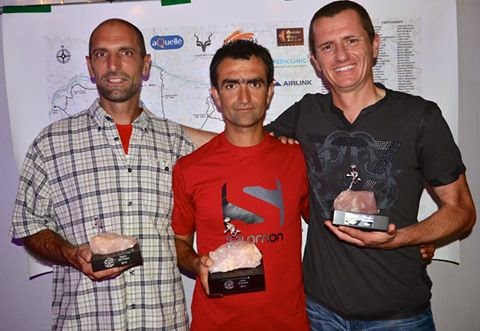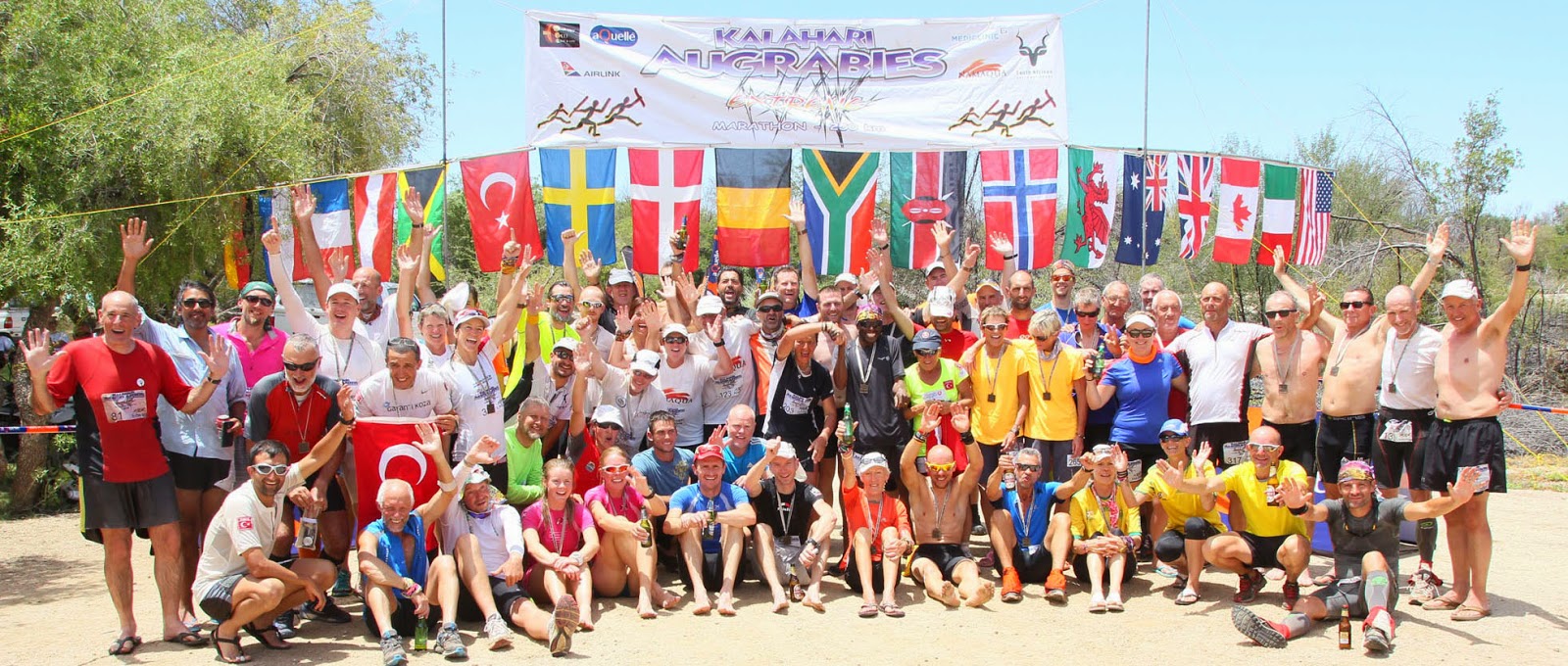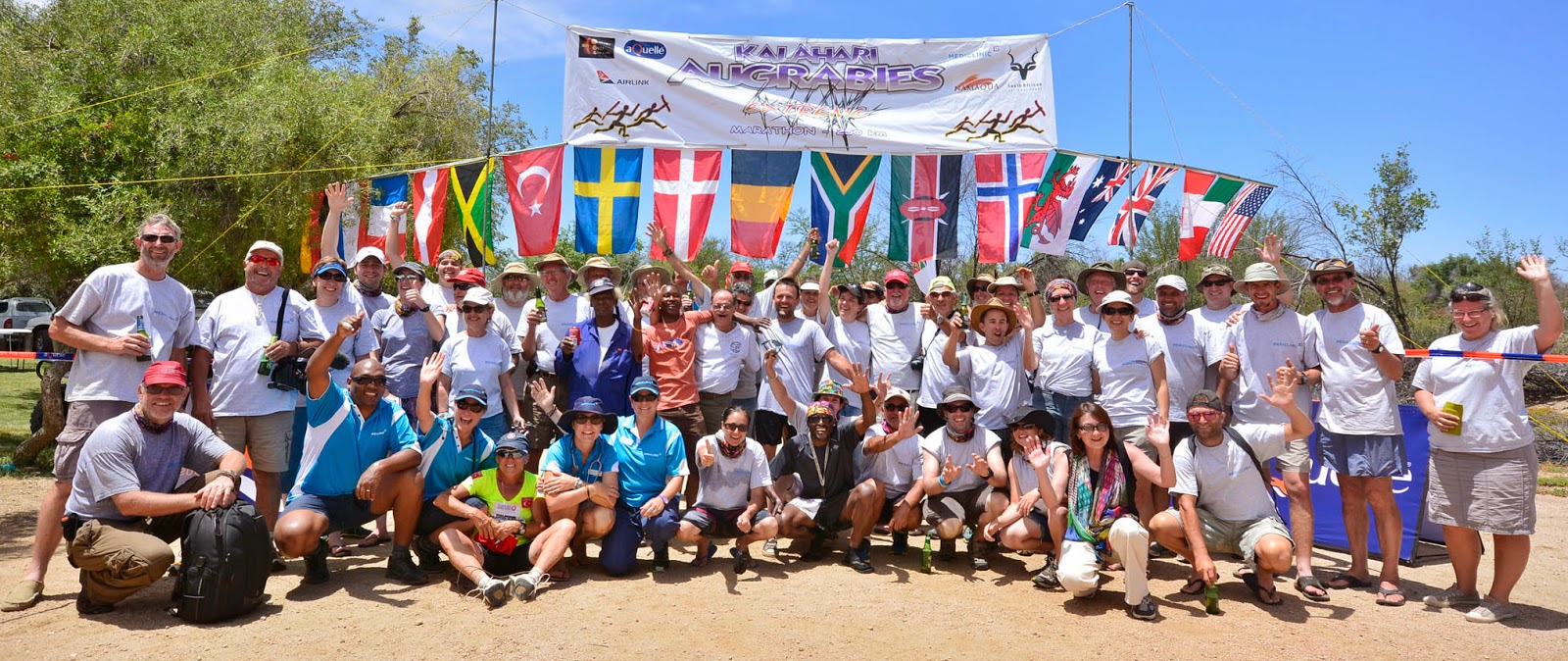(all images by Hermien Burger Webb, unless otherwise noted)
Looking to do a 7-day self-sufficient
stage race in a desert? Look no further than the Kalahari Augrabies Extreme
Marathon (KAEM), long reputed to be the best organised self-sufficient stage
race on the international trail running calendar.
KAEM had been on my bucket list for
years, and two weeks ago I had the privilege of running my first. Of all races
I’ve done in my 20 years of running, this one pips the lot hands down – the
organisation, the route, the roll out, the efficiency, the crew, the support,
the camaraderie, the friendliness, the generosity of spirit… everything about this event epitomises for me
what self-sufficient desert trail running should be about.
 |
| My 20L pack (5.8kg) and trusty Salomon Mantras |
Designed in Marathon des Sables format
(7 days, 6 stages, with the long stage, 70km, on days 4/5) but with a
far more personal approach (KAEM allows a maximum of 100 runners, versus the +1 000
that do MDS), KAEM is staged in the Kalahari Augrabies region of the Northern
Cape province of South Africa, close to the Namibian border.
Self-sufficient means just that – you
carry your food, running gear, sleeping gear and a small medical kit for seven
days. All that’s provided is water at frequent checkpoints along the way, and a
communal tarpaulin to sleep under. As long as you carry the mandatory gear, how
generous you are with what you take is up to you, and pack weights vary from as
light as 5.8kg to as hefty as 14kg.
The stages are designed to test even the
strongest runners, starting with a fairly easy 25km, a 35km, a 40km, then the
70km long stage, followed by a 45km, and finally 21km, making up a total of
236km – all in gruelling conditions.
The race always takes place during the
full moon, early in November. At that time of year, the summer heat is already
extreme, and maximum daily temperatures range from 38˚C to about 46˚C.
Did you know, it never rains in the
Kalahari.
Hang on, that’s not true at all. It was
Estienne Arndt, who is Race Organiser, Evil Route Planner and Big Boss of All
Things KAEM, who once stated with absolute authority that it NEVER rains in the
Kalahari… and it’s rained every year
during the race ever since.
Rain in a hot, dry desert means
humidity. Anyone who’s hiked or run in a desert knows that hot, dry conditions are
easier to cope with than hot humid conditions.
To add to the challenge, runners are
subject to a staggered start each day – seeded according to their cumulative
time. That means that on the long day, for example, the slowest person starts
at 6am while the race leader has to wait until 1pm before he sets off on the
70km stage. The temperature by that time is easily a tidy 37˚C.
 |
| An insider's view of tent life (pic by Altie Clark) |
The terrain underfoot varies from stony
shale to jeep track to dry, sandy riverbed, and the views from rocky gorges and
rivers to endless grassy savannah speckled with stunted camelthorn, blackthorn
and other acacias.
The Kalahari Augrabies region is rich in
wildlife, and runners had frequent sightings of springbok, eland, gemsbok,
ostrich, giraffe, and birds of prey.
The racing part of KAEM 2014
 |
| The start of KAEM 2014 |
This year there were 70 participants
from 18 countries. It was the 15th running of the event, and many of the
participants were return KAEM’ers.
 |
| Race winner Mahmut Yavuz |
Competition in the front of the field
was tough, with three times winner Dirk Cloete (SA) up against last year’s 2nd
placed Mahmut Yavuz (Turkey), Dion Leonard (Australia), who placed 6th last
year, Stephan Vernay (France) and local novice Martin Kalwenya.
Vying for top spot in the women I had
stiff competition – Lucja Leonard (Australia) came 2nd last year and had since
completed MDS 2014 and featured well in several ultras in the UK, while hard
core ultra queen Bakiye Duran (Turkey) was back for a third time, having
claimed 1st woman in 2012 and 3rd place last year. It was clear I’d have to
work damn hard to win this one!
 |
| me in one of the many dry river beds |
Apart from Stage 1 when Stephan crossed
the line in 1st spot, Mahmut dominated the entire race, every day increasing
his lead to make his final time a convincing 1hr45 lead over 2nd place Dion,
who fought hard against Stephan (3rd) and Martin (4th).
The women’s race was nail-biting – Lucja
certainly gave me a run for my money! I ran a cautious Day 1, securing a 6 min
lead, which I increased to 31 min on Day 2. Then things went pear-shaped for me
when stomach cramps got the better of me during Day 3, and I finished 5 min
behind Lucja. Then on the long stage, Lucja had an
absolute stormer, finishing a comfortable 18 min ahead of me, and shrinking my
lead to just 8 min.
 |
| Lucja and I ran the final stage together |
Thankfully on Day 5 (45km), I pulled the
proverbial rabbit out the hat – I had one of those runs where everything feels
right, and I cruised across the line 27 min ahead of Lucja, stretching my lead
to a healthy 35 min. With just a 21km stage set for the final day, the margin
between us was big enough for me to have the win secured, and Lucja and I ran
the final leg of KAEM 2014 together.
Competing in a self-sufficient race in a
remote part of the world is an experience unlike any other. You’re one of a
small group of people (ok, unless you’re doing MDS, in which case you’re one of
more than 1 000 people) in a bubble for a week, and that week is packed
with daily goals, challenges, pains, joys, disappointments, achievements – a
smorgasbord of highs and lows, a microcosm of real life. And wherever you are
in the field, you feel that week is a life truly lived.
 |
| Mahmut Yavuz, Dion Leonard (R) and Stephan Vernay (L) |
 |
| me, Lucja Leonard (L) and Bakiye Duran (R) |
It’s often said that perseverance is not
one long race, but rather many short races one after the other. That’s what
multi-stage events are all about. For everyone, whether fleet of foot or out
there for the long haul every day, each stage is tough, challenging, and calls
for a carefully measured approach – and one hell of a lot of positive thinking.
 |
| Camp manager Willem Basson with MediClinic doctors Caroline Murray (L) and Jann Killops (R) |
When the 65 finishers and more than 50
crew of KAEM 2014 bid their farewells and headed home to after their week in
the desert, they went so much the richer for their experience in the Kalahari.
Many will return another year for another round; the others will just relive
the memories.
 |
| The finishers of KAEM 2014 |
 |
| The fantastic crew behind KAEM 2014 |
In short, if you’re looking to do a self-sufficient stage race in an extremely beautiful
and special part of the world, then KAEM is the one to do. Put it on your
bucket list immediately.
Labels: Augrabies, Bakiye Duran, Dion Leonard, KAEM, Kalahari, Lucja Leonard, Mahmut Yavuz, Stephan Vernay







